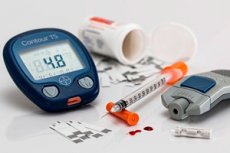Medical expert of the article
New publications
Pompom insulin therapy
Last reviewed: 04.07.2025

All iLive content is medically reviewed or fact checked to ensure as much factual accuracy as possible.
We have strict sourcing guidelines and only link to reputable media sites, academic research institutions and, whenever possible, medically peer reviewed studies. Note that the numbers in parentheses ([1], [2], etc.) are clickable links to these studies.
If you feel that any of our content is inaccurate, out-of-date, or otherwise questionable, please select it and press Ctrl + Enter.

Technique pump insulin therapy
The treatment has several modes:
- Bolus rate – the patient independently controls the frequency and dosage of the medication. This mode is used before eating or when blood sugar increases. Short-acting and ultra-short-acting drugs are recommended.
- Continuous supply in minimal doses – this mode imitates the normal functioning of the pancreas. Allows you to refuse the use of synthetic hormones of prolonged action.
The main advantage of the pump is that there is no need to administer the medicine yourself. This method is contraindicated for patients with mental disorders and for elderly patients who are unable to care for themselves (poor vision, tremors of the limbs).
Insulin pump therapy in children
A popular device used to compensate for carbohydrate metabolism in pediatric patients is a pump. It is a micropump with an electronic device for multiple injections. Since the device automatically delivers the medicine, it is very convenient for treating children and patients who do not have the time or opportunity to give injections.
The main indications for insulin pump therapy in children:
- No need for frequent and painful injections.
- Maximum physiological supply of insulin to the body.
- Absence of psychological discomfort.
- Reducing the risk of hypoglycemia.
The disadvantages of the pump method include:
- High cost of the device.
- The need to control the battery charge level of the device.
- The sensitivity of the device to electromagnetic waves.
- Risk of developing inflammatory reactions at the site of the needle delivering the medication.
- In children with insufficient subcutaneous tissue, the catheter may become kinked and the hormone supply may stop.
The pump can operate in two modes:
- Background – the drug supply ensures a stable base level of insulin in the blood. The regimen imitates the normal functioning of the pancreas. The dosage for normal functioning of the body is selected by the attending physician and depends on the rhythm of life, physical activity and other characteristics of the patient.
The device can be programmed for different rates of hormone administration – every 30 or 60 minutes. The minimum step of drug administration is 0.01 units. As a rule, the background mode is used to compensate for 1/3 of the daily dose of the drug.
- Bolus – the frequency of administration of the drug depends on the number of meals, i.e. the hormone is administered before each dose. To determine the optimal dosage, it is necessary to measure the blood glucose level before each injection for several days. 30% of the dosage is administered before breakfast, 15% before lunch, 35% before dinner and the remaining 20% before bedtime.
As a rule, two or three times the drug is administered to children. In this case, hormones with a short and medium period of activity are combined. In pediatric patients, insulin sensitivity is higher than in adults, so a gradual correction of the dosage (within 1-2 units) and careful monitoring by parents and doctors is necessary.
When choosing drugs for the treatment of children, preference should be given to short-acting human insulin analogues:
- Do not cause allergic reactions.
- Rapidly lowers blood sugar levels.
- They deteriorate quickly.
This allows the delivery of the drug to be as close as possible to the functioning of a healthy pancreas.
Despite all the advantages of using the pump, patients must strictly adhere to a diet and lead an active lifestyle. It is also necessary to consider the risk of the device failing, which can lead to sharp jumps in glucose levels and the development of ketoacidosis. The final decision on the introduction of this method is made by the doctor together with the parents.


 [
[